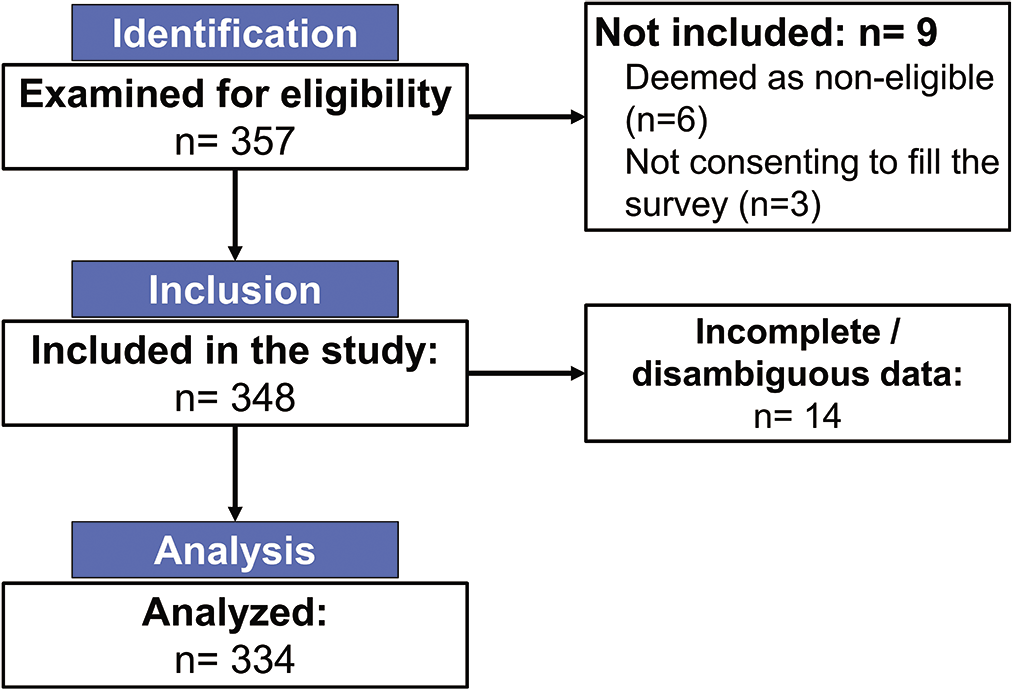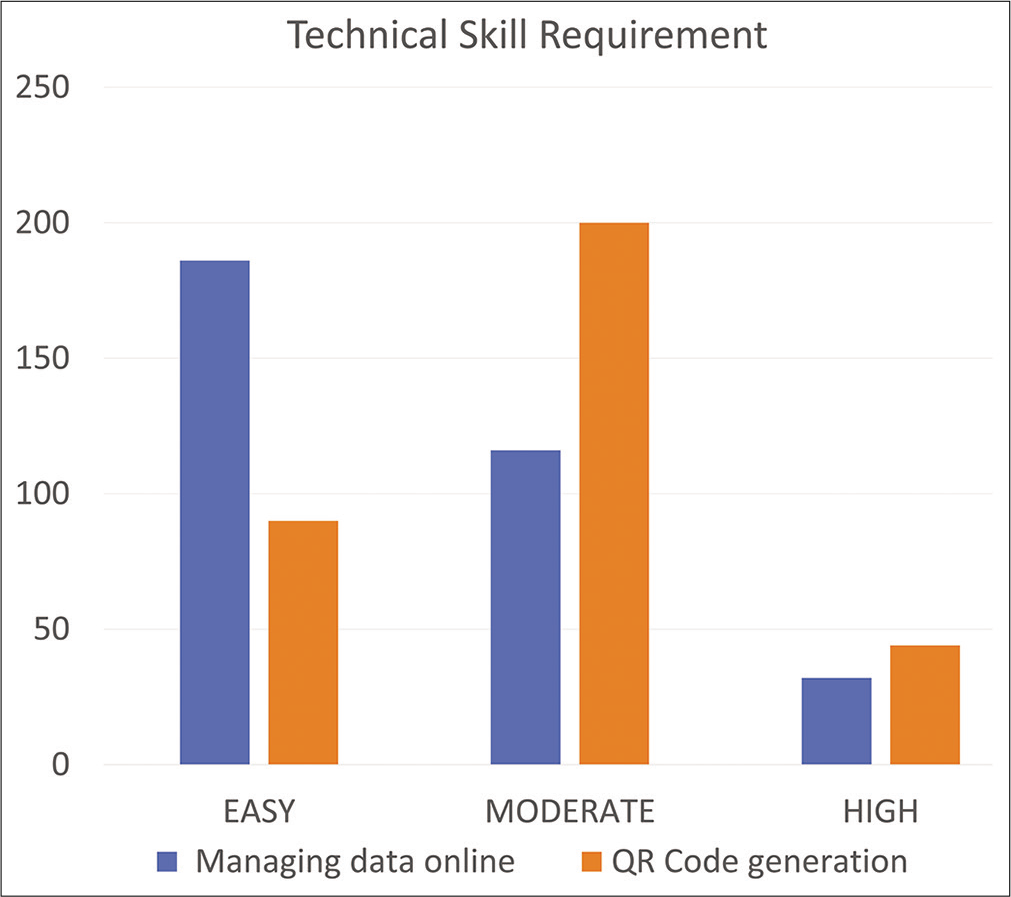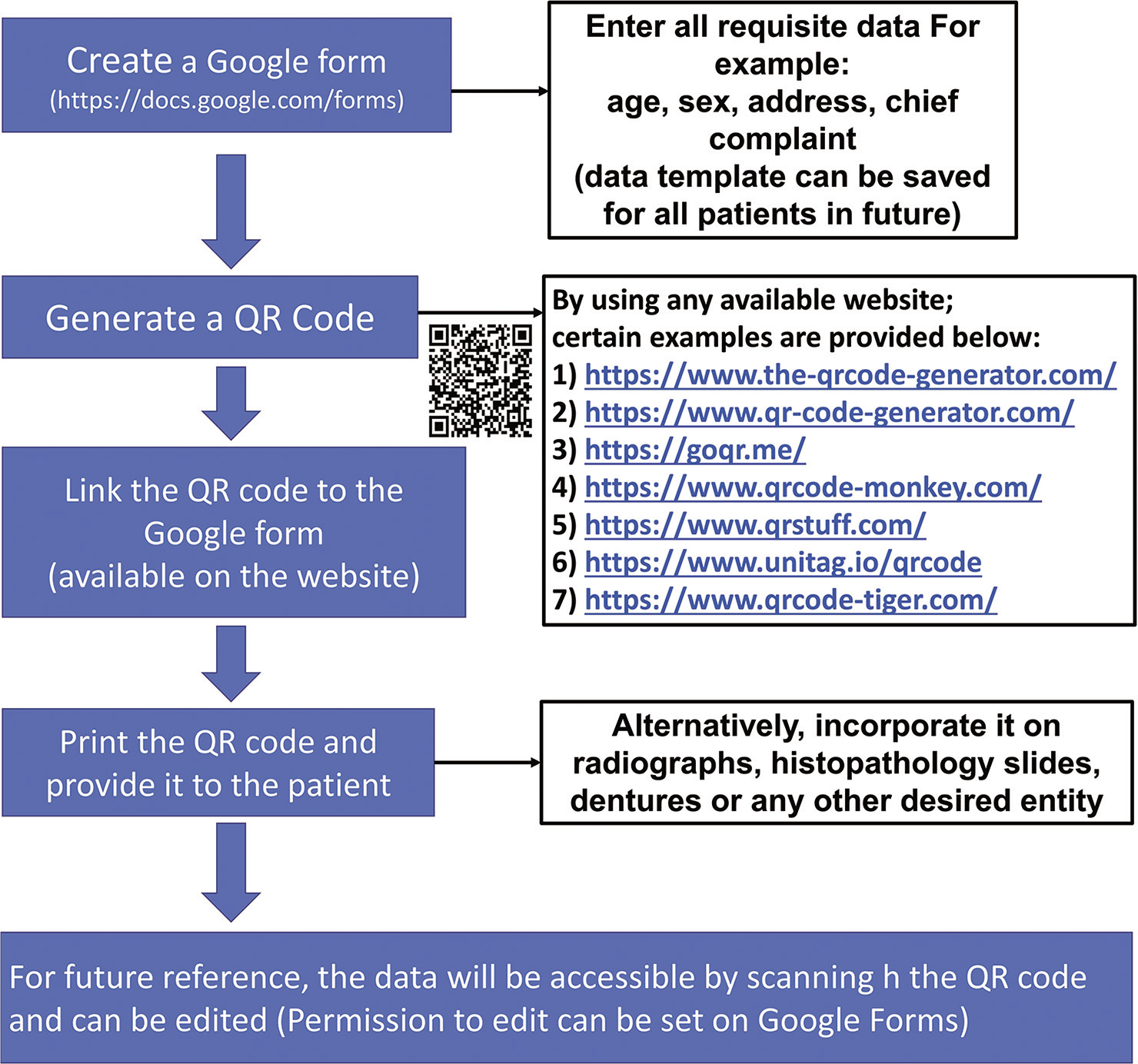Survey on knowledge, attitude, and practice of Indian oral health-care professionals regarding QR codes in dental practice and academics

*Corresponding author: Sanpreet Singh Sachdev, Department of Oral Pathology and Microbiology, Government Dental College and Hospital, Mumbai, Maharashtra, India. sunpreetss@yahoo.in
-
Received: ,
Accepted: ,
How to cite this article: Avhad SK, Sachdev SS, Jaiswal PA, Jadhav P, Watharkar RB, Save SS. Survey on knowledge, attitude, and practice of Indian oral health-care professionals regarding QR codes in dental practice and academics. J Global Oral Health 2022;5:3-8.
Abstract
Objectives:
QR codes form an integral part of modern-day digitalized information storage technology in almost all the fields. Their utility in oral health-care field also has a huge potential, most of which can be uncovered once the oral health-care professionals are aware about their uses and technique of generation.
Materials and Methods:
A self-constructed e-questionnaire was validated and circulated through online media to oral health-care professionals in India. Data were subjected to statistical analysis and descriptive statistics were obtained. Comparison of frequencies of categories of variables with groups was done using Chi-square test.
Results:
The study sample of n = 334 respondents comprised 222 females and 112 males. The age of respondents ranged from 22 to 65 years with a mean age of 28.96 years (S.D = ± 6.877). Majority of respondents were aware about the utility of QR codes in day-to-day aspects as well as dental clinical practice and academics. Although two-thirds of respondents perceived online data management as an easy task, generation of QR codes was considered as relatively more difficult requiring higher technical skills.
Conclusion:
QR codes can have a wide variety of applications in the field of dentistry such as in prosthodontics, orthodontics, oral pathology, radiology, and forensic odontology. Our findings suggest that most of the dental professionals have convenient access to the technology essential to generating QR code, and yet, about 70% of oral health-care professionals are unaware about their generation technique.
Keywords
Data management
Tele-rehabilitation
Telemedicine
Prosthodontics
Forensic dentistry
INTRODUCTION
In the present age of digitalization, huge amounts of data require to be stored and accessed through devices at multiple locations. In the earlier years of digitalization, data were located, identified, and tracked by means of codes provided in the form of alternating white and black bands, known as “barcodes.” With increasing demand of efficiency, a matrix type of two-dimensional barcode was developed in 1994 that enabled efficient storage of more information. These have been termed as “Quick Response” (QR) code which typically comprise black squares arranged on a white background grid.[1]
QR codes have become an essential part of diverse industries such as computers, manufacturing, logistics, retailing, and transportation. They are created particularly to serve the purpose of product identification, tracking, marketing, and management of relevant information. The field of health care is no stranger to requirement of data storage and remote access facilities. Storage of patient’s medical records and gaining ready access through a simple scan by a clinician at any location can drastically improve the provision of health care.[2]
Numerous applications and websites are available, at present, that enable relatively hassle-free generation of QR codes. Furthermore, these applications are freely licensed and require minimal technical requirements that comprise a smartphone and internet.[3] Considering the fact that majority of health care workers as well as patients have access to these facilities, they can be readily created and used to store and access data without any additional cost.[2,4]
Regardless, the use of QR codes is very limited among oral health care workers in India due to various possible reasons. Even if the dental professionals are aware of their utility and use it in their practice to some extent, very few are able to generate QR codes on their own. The present study aims at assessing the knowledge, attitude, and practice with respect to the utility of QR codes and the technique related to their generation of oral health-care professionals in Maharashtra, India. We have also delineated the flow process for QR code generation that can be easily incorporated in their routine clinical practice as well as academics. Additional objectives of the study include understanding of reasons pertaining to the paucity of the use of QR codes in dental field and creating awareness about the technique for their generation.
MATERIALS AND METHODS
The present cross-sectional study was conducted by means of a self-constructed e-questionnaire by a team of six researchers, including dental professionals from various fields of specialization and a public health expert. The questionnaire was constructed using Google Forms and comprised a consent statement followed by 15 questions pertaining to knowledge about the utility of QR codes, technique required for their generation, and their perceived applications in dentistry. Oral health-care professionals of Maharashtra possessing a minimum degree of BDS were considered as eligible for inclusion. Respondents not consenting to fill the survey or opting out of the survey process were excluded from analysis of results.
A pilot study was performed which comprised 20 respondents in which the questionnaire was pilot tested for face and content validity. The reliability of questions was tested using Cronbach’s alpha analysis and a value of 0.92 indicated good internal consistency and validity. Minor grammatical and language-related modifications were made to simplify the questions as deemed necessary following the pilot analysis.
Sample size was determined by means of single proportion formula[5] as below:
Where p = Estimate of the expected proportion
d = Desired level of absolute precision
Assuming the current event rate to be at least 70%.
Keeping 5% confidence limit, for p = 0.05
It was estimated that at least 323 respondents should complete the survey. The study protocol was approved by the Institutional Ethical Review board (Ethical commitee clearance reference number: GDCHMum/EthicalCommittee/4126/2020). The link to online survey form was forwarded to oral health-care professionals of India across social media platforms and messenger applications. The participants were encouraged to share the survey to their contacts as well, for increasing the participation and response rate of the questionnaire. A final sample size of n = 334 respondents was obtained after scrutinizing for eligibility [Figure 1].

- STROBE flow diagram indicating the process of inclusion/ exclusion of respondents in the study for final analysis.
The data obtained from respondents were entered into a MS Office Excel Sheet (v 2016, Microsoft Redmond Campus, Redmond, Washington, United States). Data were subjected to statistical analysis using Statistical Package for the Social Sciences v 26.0, IBM. Descriptive statistics such as frequencies and percentage for categorical data, mean and SD for numerical data have been depicted. Comparison of frequencies of categories of variables with groups was done using the Chi-square test. For all the statistical tests, P < 0.05 was considered to be statistically significant, keeping α error at 5% and β error at 20%, thus, giving a power to the study as 80%.
RESULTS
The study sample of n = 334 respondents comprised 222 females and 112 males. The age of respondents ranged from 22 to 65 years with a mean age of 28.96 years (S.D = ± 6.877). About two-thirds of respondents (69.5%) had an educational qualification of BDS, while the remainder had an MDS qualification. The respondents comprised postgraduates (n = 152), private practitioners (n = 128), associate dentists (n = 42), and institutional faculty (n = 12). The mean work experience of respondents was 4.12 years (S.D = ± 4.920).
The percentages of responses to questions relevant to awareness of the respondents regarding the utility and generation of QR codes are depicted in [Table 1].
| Awareness about | % of respondents aware | % of respondents not aware |
|---|---|---|
| Use of QR codes in various day-to-day utilities | 98.8 | 1.2 |
| Use of QR codes in identification and linking of scientific publications | 86.2 | 13.8 |
| Use of online database management tools such as Google Drive | 96.4 | 3.6 |
| Applications in smartphones utilized for scanning QR codes in general | 91.0 | 9.0 |
| Applications/technologies that are used in generating QR codes in general | 30.5 | 69.5 |
It was evident that majority of respondents were unaware about applications or technology required for the generation of QR codes. There was a statistically significant (P = 0.022) difference noted with greater frequency of BDS respondents being not aware about the QR code generation process. There was also a statistically highly significant (P ≤ 0.001) difference noted with a greater number of male respondents familiar with the applications required for the generation of QR codes.
Although majority of respondents (91.6%, n = 306) agreed that digital data entry with QR code given would be better modality as compared to conventional case paper, only about 40.7% of respondents (n = 136) had come across the use of paperless (digital) OPD in their practice or institution. A statistically highly significant difference (P ≤ 0.001) was noted with greater frequency of MDS respondents being aware about the digital OPD system.
When considering various aspects of dentistry, majority of respondents agreed that QR codes would be useful in prosthodontics (82.6%, n = 276), orthodontics (75.4%), histopathology (83.2%), and forensic odontology (81.4%). A statistically significant (P = 0.043) difference was observed in number of responses with greater number of MDS respondents acknowledging the utility of QR codes in the field of prosthodontics.
Managing data online using applications such as Google Drive was perceived as an easy task requiring less technical skills by the respondents. Whereas, generation of QR codes was perceived as a relatively more difficult task requiring moderate technical skills by majority of the respondents [Figure 2].

- Technical skill requirement for the management of data online and QR code generation as perceived by the respondents.
A statistically significant difference (P = 0.035) was observed with a greater frequency of BDS respondents perceiving technical skills required for online data management as easy.
DISCUSSION
Eliciting a patient’s history of dental pathologies and past treatment is extremely crucial for treatment planning in dentistry. For example, a prosthodontist would need to know details about a patient’s root canal treatment or radiologist, pathologist, as well as surgeons would require details related to a lesion. The conveyance of information may not always happen directly between the professionals, as they may not be present at the time of procedure. This could lead to certain information being missed out when the records are conveyed later. Furthermore, the information could further be distorted when it is conveyed through someone other than the professional, for instance, their assistant. This could possibly make the diagnosis of a case more challenging or may even lead to misdiagnosis. Information stored in a database that can be readily accessed through QR code will ensure unanimous interpretation of data across multiple professionals involved in different aspects of a case.[6]
As compared to conventional one-dimensional bar codes that contain approximately 20 digits in a single direction, one QR code can encode up to 7000 characters. Thus, QR codes can store same amount of data in only one-tenth of the space owing to the added second dimension and are able to store several dozen to 100 times the amount of information.[7] In addition, decoding a QR code is possible even if up to 30% of the data are corrupted or damaged.[1]
What makes it even more beneficial is that even there are unrelated practitioners at different locations with no means of contacting each other, they can still gain access to all of the patients records instantaneously.[6] This is actually the need of the hour in the present COVID-19 pandemic. Paperless electronic health-care record systems can enable a more efficient and safer mode of data storage, much crucial for limiting the spread of infection.[8]
Recent studies have found that most of the patients (90%) and dental professionals (100%) are fluent with the use of smartphone technology and apps, much similar to our findings (96.4%).[9] Even so, most of the oral health-care professionals are not aware of the technique for the generation of QR codes, as dictated by our findings. Findings from recent studies also suggest that individuals from younger age groups tend to learn newer technical procedures faster.[10] Therefore, utility of QR codes by. [Figure 3] delineates the process of incorporating QR code in clinical practice.

- Flow process for incorporation of QR codes into clinical practice.
A number of institutes and hospitals utilize QR codes for tagging the identity of their employees.[4] This ensures a secure login and entry mechanism ensuring smooth working of a workplace. Histopathological slides are also labeled with QR codes in tertiary care centers that lead to the patient history and complete medical record. Similarly, radiology and diagnostic imaging departments can incorporate QR codes in the radiographs or other scans.[11]
A QR code may be incorporated within the denture of a patient. Information relevant to patient’s pre-denture and denture fabrication could then be stored in the database linked to the code.[12] These could be utilized for denture repair or fabrication in future even if the patients consult a prosthodontist at different locations. Overall, the quality of care provided to the patient would drastically improve, which is much needed for elderly edentulous patients.[13] The geriatric population can also avail benefits of telemedicine and teledentistry, in which, QR codes can play a pivotal role.[10] Similarly, population with special health-care needs such as pregnant women or children can avail these facilities at their place of residence.[14]
A similar application could be possible in the field of orthodontics.[15] A patients pre-treatment records could be stored as a baseline including radiographic images. The subsequent radiographs or findings during the course of treatment could then periodically be added. These could be utilized for patient education regarding the results of treatment. Headgears or intraoral appliances such as Hawley retainers can be effectively utilized for incorporation of QR codes during orthodontic treatment.[12,15] Recent studies have demonstrated a similar application of QR codes in appliances used for pediatric patients.[11]
Personal identification in mass disasters can be an arduous task particularly if external damage to the face has occurred. The QR codes incorporated in dental prosthesis would lead to quick and easy identification of an individual.[12,16] The QR codes are also able to withstand excessive temperatures generated in the fabrication or modification of oral prosthesis.[16] It would also minimize the time required for age estimation in medicolegal cases wherein extensively tedious methods have to be used with limited accuracy.[17]
A dental professional can access clinical information and diagnosis support by ease in access to online dental textbooks, credible videos, professional guidelines, drug references, literature relevant to a dental material, and instructions for the use of a respective product.[18] It was agreed by 78.3% of the respondents that practitioners in rural areas will be able to access at least minimal technology required for QR code scanning, that is, only a smartphone with internet connection. Considering the minimal facilities required for the generation and use of QR codes, it would empower researchers in rural areas and further encourage them.
In addition, QR codes can also be used to give access to students to online surveys, faculty feedback, and course evaluation forms and the student’s progress/assignments or projects can be reviewed with easy access to student digital portfolios for regular updates, each student can be assigned a QR code at the beginning of the year or start of their course. They can then be utilized to subsequently add academic progress or linking scientific publications to the student’s profile.[9]
CONCLUSION
QR codes have a wide variety of applications in the field of dentistry such as in prosthodontics, orthodontics, oral pathology, radiology, and forensic odontology. Our findings suggest that most of the dental professionals have convenient access to the technology essential to generate QR code. Even so, about 70% of oral health-care professionals are unaware about their generation technique and thus fail to utilize their full potential in the field of dentistry. The simple step-by-step delineation of the process in our study could help the dentists who wish to incorporate QR codes in their practice.
Declaration of patient consent
The authors certify that they have obtained all appropriate patient consent.
Financial support and sponsorship
Nil.
Conflicts of interest
There are no conflicts of interest.
References
- Denso Wave Incorporated QRcode Aichi (JP) Denso Wave Incorporated. 2014. Available from: http://www.qrcode.com/en [Last accessed on 2021 Aug 01]
- [Google Scholar]
- QRStream: A secure and convenient method for text healthcare data transferring. Annu Int Conf IEEE Eng Med Biol Soc. 2019;2019:3458-62.
- [CrossRef] [PubMed] [Google Scholar]
- Information Capacity and Versions of QR Code. 2021. Available from: https://www.qrcode.com/en/about/version.html [Last accessed on 2021 Aug 01]
- [Google Scholar]
- Evaluation and implementation of QR code identity tag system for healthcare in Turkey. Springerplus. 2016;5:1454.
- [CrossRef] [PubMed] [Google Scholar]
- The importance of communication in dentistry. Dent Update. 2017;44:774-80.
- [CrossRef] [Google Scholar]
- Affordable digital innovation to reduce SARS-CoV-2 transmission among healthcare workers. S Afr Med J. 2020;110:605-6.
- [CrossRef] [PubMed] [Google Scholar]
- Using QR codes in dental practice In: EDULEARN19 Proceedings 11th International Conference on Education and New Learning Technologies. Palma, Spain: IATED Academy; 2019. p. :434-9.
- [CrossRef] [Google Scholar]
- Suitability for elderly with heart disease of a QR code-based feedback of drug intake: Overcoming limitations of current medication adherence telemonitoring systems. Int J Cardiol. 2021;327:209-16.
- [CrossRef] [PubMed] [Google Scholar]
- An in vitro evaluation of the reliability of QR code denture Labeling technique. J Forensic Dent Sci. 2016;8:179.
- [CrossRef] [PubMed] [Google Scholar]
- Denture Labe ling using QR codes. A simplified technique. Int J Dent Sci. 2018;20:11-5.
- [CrossRef] [Google Scholar]
- Prevalence and knowledge of heavy menstrual bleeding among African American women. Int J Gynaecol Obstet. 2014;125:56-9.
- [CrossRef] [PubMed] [Google Scholar]
- Quick response codes in orthodontics. J Indian Orthod Soc. 2015;49:50-1.
- [CrossRef] [Google Scholar]
- Behavior of 4 types of paper with printed QR codes for evaluating denture marking in conditions of extreme heat. J Prosthet Dent 2020
- [CrossRef] [PubMed] [Google Scholar]
- A novel visual secret sharing scheme based on QR codes. Int J Digit Crime Forensics. 2017;9:38-48.
- [CrossRef] [Google Scholar]
- Smartphones in clinical practice, medical education, and research. Arch Intern Med. 2011;171:1294-6.
- [CrossRef] [PubMed] [Google Scholar]







